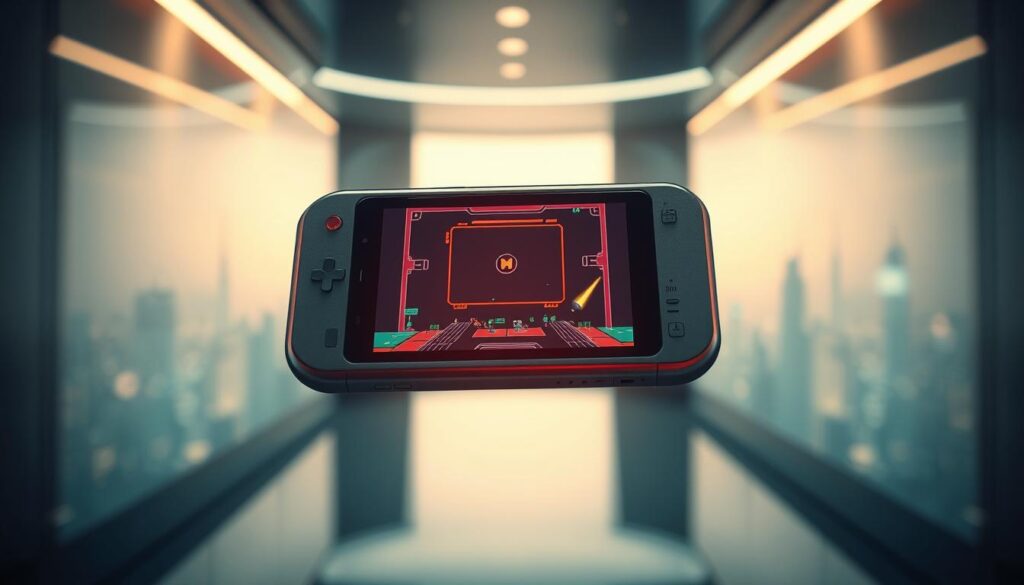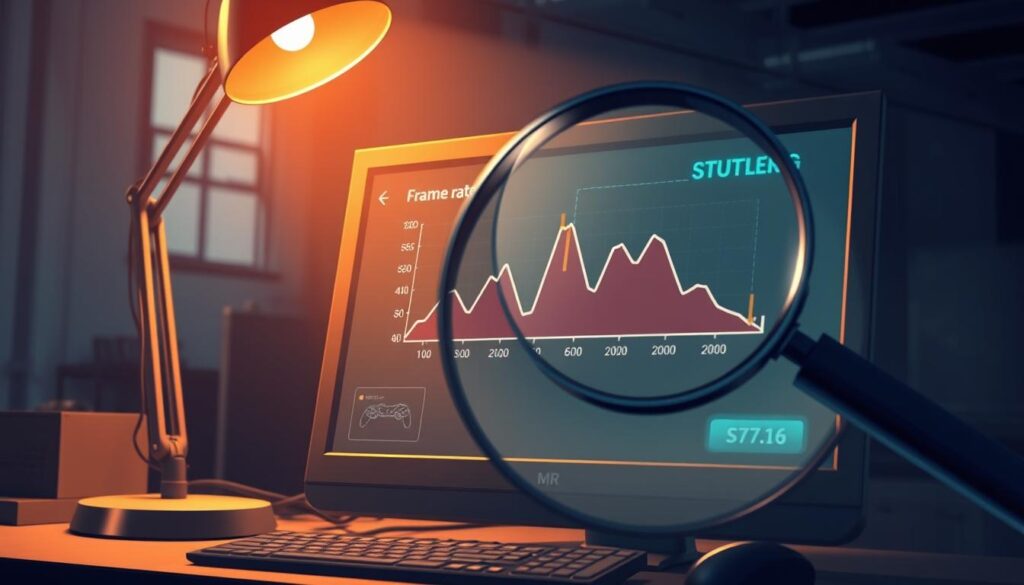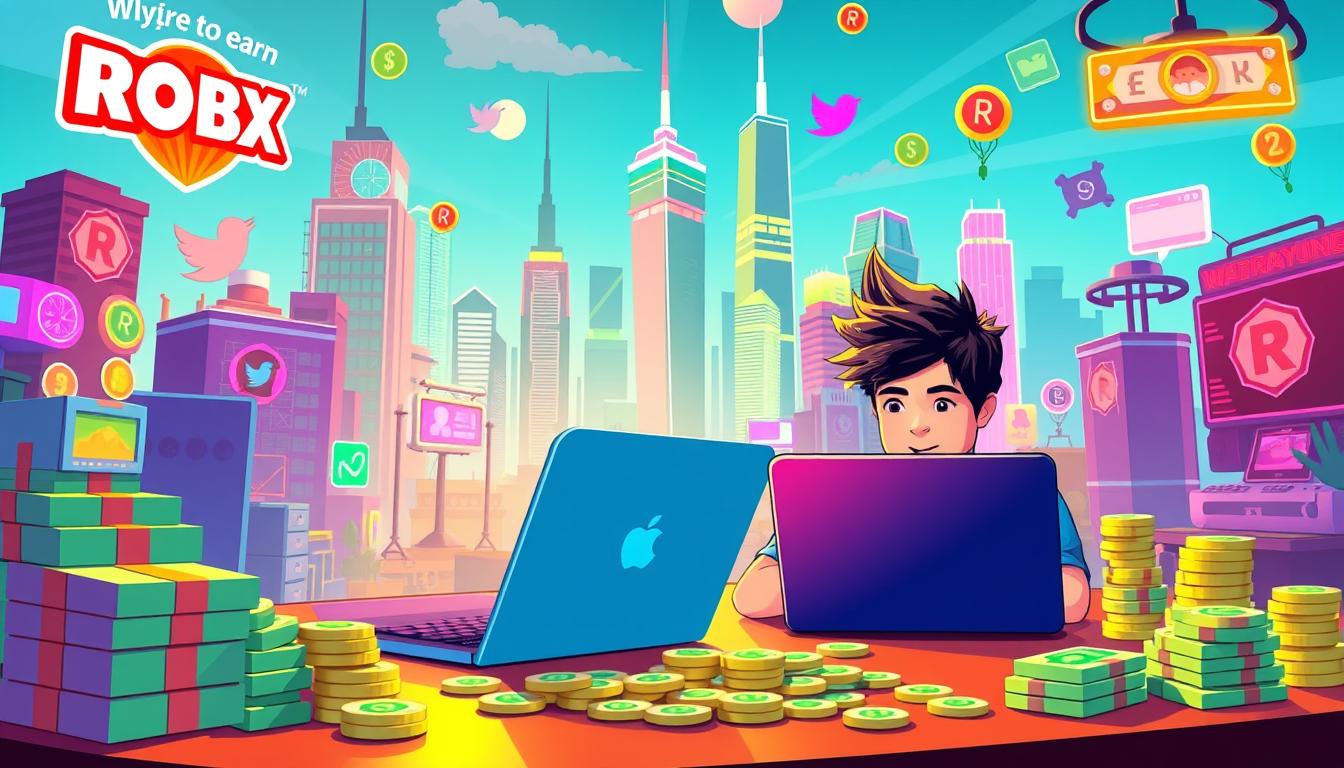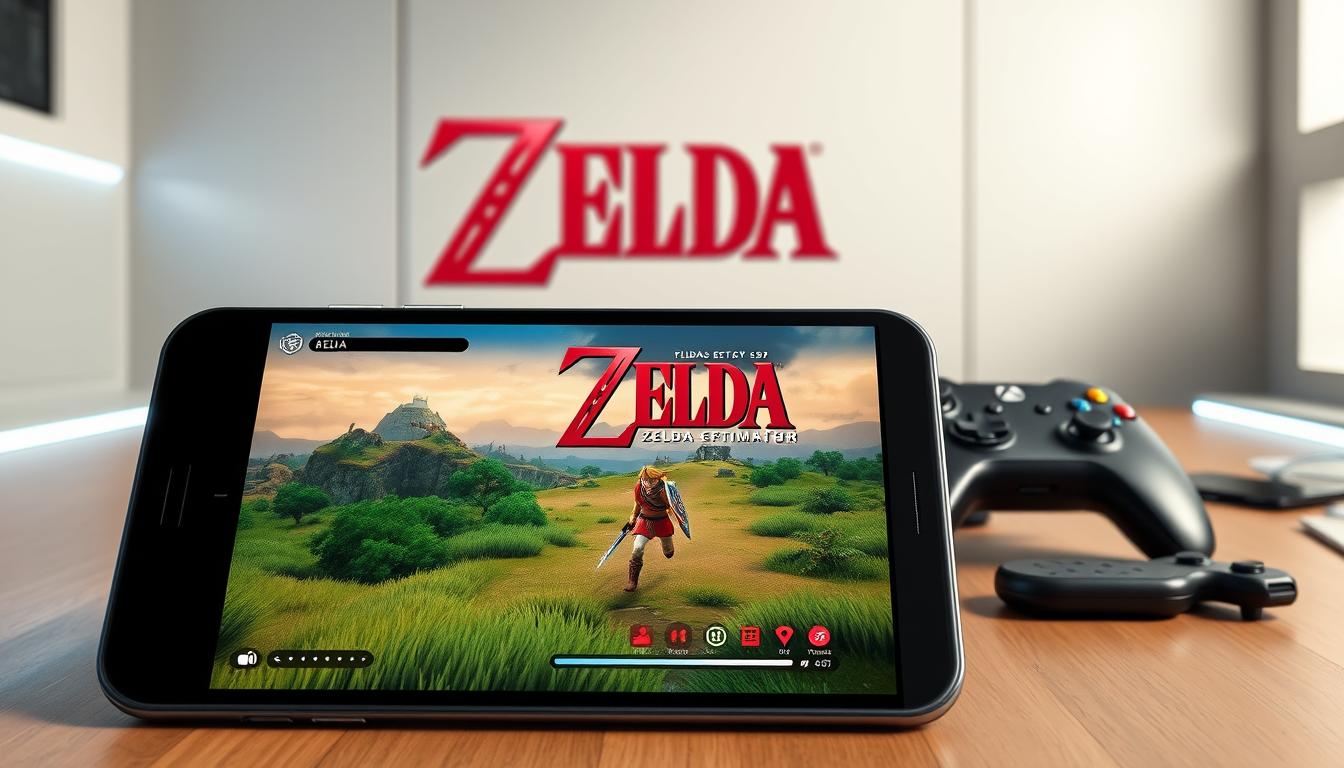Anúncios
Ever thought about making your old Android phone better for games? Emulators have changed the game, making it possible to improve FPS and cut down on stutter. This article will show you how these tools can make your gaming smoother, without the need for expensive new parts. Get ready to learn about emulators and how they can take your mobile gaming to the next level.
The Rise of Mobile Emulation
Mobile emulation has become a big deal in gaming history. With powerful Android devices everywhere, it’s easy to play classic games again. This has sparked a new interest in retro gaming among people of all ages.
The start of mobile emulation was about making old games work on new devices. As tech got better, developers made smartphones act like old consoles. Now, there are thousands of apps for Android that let you play classic games right away.
Anúncios
Because of this, many online forums and platforms have popped up. They’re where gamers share tips and updates. This shows how much people care about keeping gaming history alive and making retro games fun on today’s devices. Mobile emulation keeps growing, offering a great place for both new and experienced gamers.

Understanding Frame Rate and Stutter
Frame rate is key to good gaming on mobile devices. It’s the number of frames shown per second (FPS). A higher frame rate means smoother gameplay. But, a lower rate can cause stuttering, making games less fun.
Anúncios
Most games aim for a 60 FPS rate. However, fast games might need even more to feel right. This ensures a smooth experience.
Stuttering happens when devices can’t keep up with the frame rate. This is common on older phones with less power. Knowing how frame rate and stuttering work together helps improve gaming on these devices.
Emulators can help by boosting frame rate and reducing stutter. They make games run smoother. This brings older phones back to life, making gaming enjoyable again.

How Emulators Work
Emulators are key to playing old games on new devices. They act as bridges, connecting old software to new hardware. This lets games from outdated systems run smoothly on today’s gadgets. Emulators do this by translating game code into actions that mimic the original hardware.
At the heart of this magic is a detailed software design. It must perfectly mimic the original hardware’s behavior. This is crucial for smooth gameplay, as any errors can cause problems.
Thanks to ongoing tech advancements, emulators have become more advanced. They use new methods to improve how well they work. This makes it easier for fans to enjoy classic games on their mobile devices.
Emulators to Improve FPS in Old Android Phones
Emulators are key for better gaming on older Android phones. They let users play classic console games on their devices. This makes retro gaming on Android smoother and more enjoyable.
Types of Emulators Available
There are many emulators for Android, each for different games. Here are some popular ones:
- PlayStation Emulators: Enjoy original PlayStation games with better graphics and smoother play.
- Nintendo 64 Emulators: Speed up classic Nintendo games on today’s devices.
- Sega Genesis Emulators: Get faster FPS and less lag in retro Sega games.
- Multi-console Emulators: Apps like RetroArch let you play games from many platforms, offering a huge game library.
Benefits of Using Emulators
Using emulators brings many benefits to gaming. Here are some:
- Enhanced Graphics: Emulators often support better graphics, like higher resolution and lighting.
- Greater Control Over Performance Settings: Adjust settings to boost FPS and match your device’s capabilities.
- Access to a Vast Library of Games: Explore gaming history with thousands of games available.
- Customization: Personalize your gaming experience with custom controls and settings.
Setting Up Emulators on Android
Setting up emulators on Android needs careful steps. First, download the emulator app from the Google Play Store or side-load it. Dolphin Emulator is great for GameCube and Wii games, while PPSSPP is perfect for PlayStation Portable games. Each emulator offers special features for different gaming needs.
After installing, tweak the user interface to your liking. Adjust graphics and control settings for better gaming. Getting to know the emulator’s features well can make your games run smoother.
Setting up directories for your ROMs is key. Organizing games in folders makes your library easy to manage. This keeps your Android gaming space neat as you add more games.
Here’s a quick installation guide for setting up your emulator:
| Step | Action |
|---|---|
| 1 | Download the emulator app from the Play Store or side-load. |
| 2 | Open the app and adjust the user interface settings. |
| 3 | Create designated directories for ROMs. |
| 4 | Load your chosen ROMs into the respective folders. |
| 5 | Start playing your favorite Android gaming titles! |
Follow these steps for a great emulator setup. It’s the first step to enjoying games on your Android device.
Choosing the Right Emulator for Your Device
Choosing the right emulator for your device is important. You need to look at processor type, memory, and GPU compatibility. These factors affect how well an emulator works on your device.
First, check your device’s hardware. Devices with strong processing power and lots of RAM do better with complex emulation. Also, know your device’s operating system and architecture. This helps find emulators that work well with your device.
Think about what games you like. Some emulators are better for certain types of games. Look at user reviews and performance tests to see how different emulators work. Emulators like RetroArch or Dolphin might perform differently on your Android phone.
The table below shows some emulators, their compatibility, and how well they work on Android devices:
| Emulator | Device Compatibility | Performance Rating |
|---|---|---|
| RetroArch | Wide compatibility (Android 4.1+) | 9/10 |
| Dolphin | 64-bit devices (Android 5.0+) | 8/10 |
| ePSXe | Most Android devices (Android 2.3+) | 9/10 |
| PPSSPP | Various devices (Android 2.3+) | 9/10 |
In conclusion, knowing your device’s specs and the performance of emulators is key. Choosing the right emulator for your device will improve your gaming experience. It will make your old Android phone work better and smoother.
The Impact of Hardware on Performance
It’s important to know how hardware affects emulator performance on older Android devices. The processor and RAM are key to how well emulators work. Different processors, like Snapdragon and MediaTek, perform differently. This affects how well games run.
Users need to check their device’s specs to get the best gaming experience. This means avoiding frame rate drops and stuttering.
Processor and RAM Considerations
The processor’s role in gaming emulation is huge. A fast processor makes games run smoother and load faster. For example, Snapdragon chips usually beat MediaTek chips in emulator performance.
RAM is also crucial. Emulators need a lot of RAM to run well. Not enough RAM causes lag and poor performance. So, users with older devices might need to upgrade RAM or choose less demanding emulators.
| Processor | Performance Level | Recommended RAM |
|---|---|---|
| Snapdragon 865 | High | 8 GB or more |
| MediaTek Dimensity 1000 | Medium | 6 GB or more |
| Snapdragon 732G | Medium | 6 GB or more |
| MediaTek Helio G85 | Low | 4 GB or more |
Choosing the right processor and RAM is essential for great emulator performance. By understanding these components, users can make better choices. This leads to a better gaming experience on their devices.
Configuration Tweaks for Optimal Performance
Adjusting emulator settings is key to better gaming. By trying different settings, you can make games run smoother. Start by tweaking visual settings. Lowering graphics can boost frame rates, making games smoother on older devices.
Don’t forget about frame rate settings. Many emulators let you set a frame rate cap. This keeps gameplay stable. If you notice lag, try enabling frame skipping. It makes games feel smoother by skipping frames when not needed.
Also, check out CPU emulation settings for more speed. Features like multi-threaded rendering can split tasks, making games more responsive. Keep an eye on your device’s performance to find the best settings for you.
Remember, each game is different. Keep trying new settings to find what works best. Keeping track of your changes helps you fine-tune for the best performance.
Utilizing Frontend Applications for Better Management
Frontend applications are key in managing emulators, making it easier to organize games. They help users access different emulators and games smoothly. Tools like Emulation Station and LaunchBox offer features that improve gameplay and make organizing games simpler.
Emulation Station lets users create a beautiful interface for their games. It shows games with artwork and descriptions, making it easy to find what you want. LaunchBox also has features like customizable filters and better game settings management.
Using these frontend apps changes how gamers manage their libraries. It makes finding games quick and fun. This leads to better management of emulators and a more enjoyable gaming experience.
Advanced Techniques: Using High-Performance Drivers
High-performance drivers are key to better emulator performance on Android devices, especially those with Snapdragon processors. They make the emulator work better with the hardware. This boosts gaming efficiency and improves the user experience.
Turnip is a notable third-party driver. It makes emulators work better with Snapdragon’s power. Using drivers like Turnip, users get smoother gameplay and less lag. This makes games run better on older devices that struggle with demanding games.
| Driver Name | Emulator Compatibility | Performance Enhancements |
|---|---|---|
| Turnip | Multiple emulators (including Yuzu and Ryujinx) | Improved frame rates, reduced stutter, better graphics rendering |
| Adreno GPU Drivers | Various gaming and graphic applications | Optimized rendering, enhanced performance in graphics-intensive games |
For better gaming, using these drivers is a smart choice. They make games run smoother on older devices. By choosing the right drivers, Android gamers can get a better experience.
Installing and Managing ROM Libraries
Managing ROMs is key for emulator fans. Setting up a game library needs careful planning. It’s important to source ROMs correctly for smooth emulator use.
Start by organizing your ROMs in a clear folder. Use simple, descriptive names to make them easy to find. Organizing by console or genre makes your library more enjoyable to use.
Remember, copyright laws apply to ROMs. Make sure you’re allowed to download the games you want. BIOS files are also crucial for full emulator use. Keeping them with your ROMs makes setup easier.
Use tools for better ROM management. These apps help sort and find ROMs, making your library easier to manage. Regular updates and backups protect your collection and ensure a smooth gaming experience.
Improving Graphics and Reducing Lag
To make games run better on emulators, you need to tweak graphics and cut down on lag. Adjusting emulator graphics settings can make visuals better without slowing down the game. Start by changing the resolution. Lower resolutions use less power, while higher ones make things look better.
Frame rate settings are key for smooth gameplay. Emulators let you change frame rates to match the game’s original speed. This tweak, along with better graphics, cuts down on stuttering and lag.
Input lag affects how fast you can react in games. Turning on ‘sync’ or ‘buffering’ in graphics settings can help. Trying out these options makes gameplay feel more natural and fun.
For the best results, consider these settings:
| Setting | Recommended Value | Purpose |
|---|---|---|
| Resolution | 720p or Auto | Enhances visuals while reducing strain |
| Frame Rate | Match Game’s Native Rate | Minimizes stutter and ensures fluidity |
| V-Sync | Enabled | Reduces screen tearing |
| Input Buffering | Enabled | Decreases input lag |
Making these changes in emulator graphics settings can greatly improve your gaming experience. Finding the right balance between looks and performance is key for fun on older devices.
Streaming vs. Local Emulation
When looking at gaming options for older Android phones, we find two main ways: streaming and local emulation. Each method has its own needs and perks, fitting different tastes and device strengths.
Streaming gaming uses the internet to send games from servers to your phone. It’s great for playing top games without using too much phone power. Services like NVIDIA GeForce NOW and Xbox Cloud Gaming let you play many games on less powerful phones. The big plus is the huge game library you can access without needing lots of local resources.
Local emulation, however, runs games straight from your device. It might need some setup at first. But it gives you a game experience that doesn’t need the internet. It often means faster game starts and lower lag. Yet, it depends a lot on your device’s power. Older phones might have trouble with demanding games, causing stutter or lower frame rates.
Looking at both methods helps us see their good and bad sides, as shown in the table below:
| Feature | Streaming Gaming | Local Emulation |
|---|---|---|
| Internet Requirement | Needs stable connection | No internet needed |
| Hardware Dependency | Less demanding on hardware | Heavily reliant on device performance |
| Game Library | Access to many titles via subscription | Limited to games you have locally |
| Latency | Can experience lag | Generally faster response times |
Deciding between streaming and local emulation greatly affects gaming on older Android phones. Each option has special benefits for different users, making sure fun gaming is still possible.
Common Challenges and Troubleshooting
Using emulators on old Android devices can cause common issues. These problems often come from outdated hardware or software. They can lead to crashes or slow performance. It’s key to know why these issues happen and how to fix them.
Lag and performance problems are another big challenge. These slowdowns can be due to not enough memory or power. To solve these, try reducing graphics settings or closing apps you don’t need.
Here’s a table with common emulator problems and ways to improve performance:
| Common Issue | Possible Causes | Performance Solutions |
|---|---|---|
| Compatibility Issues | Outdated Android OS, emulator version | Update Android OS and emulator to the latest version |
| Lag During Gameplay | Insufficient RAM, high graphics settings | Lower graphics settings and close unnecessary apps |
| Frequent Crashes | Poor system resource allocation | Restart device, allocate more resources to the emulator |
| Audio Glitches | Driver or configuration errors | Configure audio settings or update audio drivers |
| Stuttering Performance | Overheating device, background processes | Ensure device has proper ventilation and limit background tasks |
By using these performance solutions, you can greatly improve your experience with emulators. Tackling common issues with effective emulator troubleshooting ensures a better gaming experience on older Android devices.
Conclusion
Exploring emulator benefits shows how they change the game on older Android devices. They help boost frame rates and cut down on stutter. This makes games run smoother without needing new hardware.
These tools bring back classic games and make them run like new. They meet today’s gaming standards.
Knowing how emulators work and setting them up right is key. Learning how to optimize them can make your gaming better. It turns old phones into game consoles that can compete with the latest ones.
Using emulators can make games more fun on devices that struggle. This article has shared tips and tricks. We hope readers will explore emulators and enjoy their gaming more.
FAQ
What are emulators and how do they work on Android devices?
Emulators are software that make older games work on new devices. They translate game code to run smoothly on Android. This way, you can enjoy classic games on your phone.
How can I improve the frame rate while using an emulator on my old Android phone?
To boost frame rate, tweak the emulator’s visuals and performance settings. Use high-performance drivers for better results. A steady frame rate makes games run smoothly.
Are there specific emulators recommended for classic consoles on Android?
Yes, ePSXe is great for PlayStation games, M64Plus FZ for Nintendo 64, and gensoid for Sega Genesis. These emulators enhance graphics and control performance.
What are the steps involved in setting up an emulator on my Android device?
First, download the emulator from the Google Play Store or side-load it. Then, set up the interface, organize ROMs, and adjust settings for the best performance.
How do I manage and install ROMs effectively for my emulator?
Find compatible ROM files, organize them in folders, and check they work with your emulator. Always follow copyright laws when getting ROMs.
What are the advantages of using frontend applications for emulators?
Frontend apps like Emulation Station and LaunchBox help manage emulators and games. They offer a better interface for accessing and organizing games.
What performance improvements can I expect from using high-performance drivers?
High-performance drivers, especially for Snapdragon devices, boost emulator performance. Drivers like ‘Turnip’ improve compatibility and efficiency for better gaming.
How does my device’s hardware impact emulator performance?
Your device’s hardware, like the processor and RAM, affects emulator performance. Choose the right emulator for your device’s specs for the best experience.
How can I reduce input lag during gameplay?
Adjust frame rate settings and optimize visuals to reduce input lag. Use settings tailored for your emulator. Balance performance and visuals for a great gaming experience.
What are the common challenges faced while using emulators, and how can I troubleshoot them?
Issues like compatibility, lag, and crashes are common. Update your emulator, check device specs, and tweak settings for smoother play.




